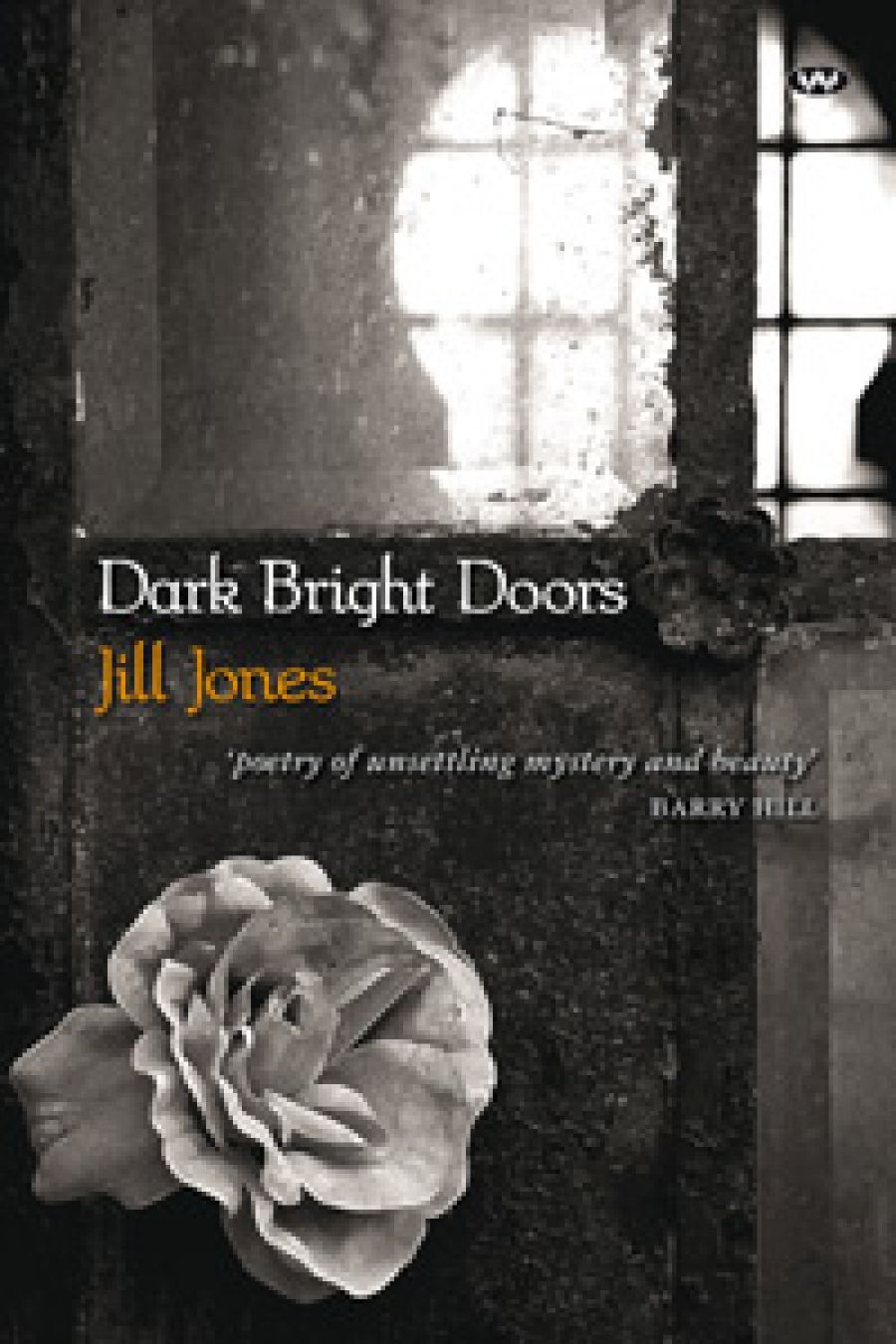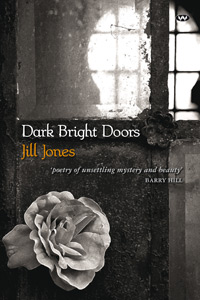
- Free Article: No
- Contents Category: Poetry
- Review Article: Yes
- Article Title: 'Let's get lost'
- Online Only: No
- Custom Highlight Text:
In Dark Bright Doors, her tenth book, Jill Jones again explores a sense of contradiction. Perhaps in tune with this theme, Jones’s work here also shows two distinct types of poems, one that is part-hallucinatory, invoking the elements ‘air’, ‘water’ and an encompassing natural world of breath, rain, sky, sun, wings. In these poems, Jones attempts to describe the indescribable, to remark on or absorb the world’s beauty and peril. Many of these poems consequently feel insubstantial and vague, though that may be their aim – to suggest, to hint at something, to sketch in mystery, rather than to pin it down.
- Book 1 Title: Dark Bright Doors
- Book 1 Biblio: Wakefield Press, $19.95 pb, 84 pp
- Book 1 Cover Small (400 x 600):

As with much recent poetry, the driving forces are description and imagination rather than intellect or analysis; rarely is sentiment uppermost. But these brief phrases of apostrophising, though often intentionally funny, can feel disembodied, as if elaboration may evaporate the poem. These seemingly selfless, often repetitive, emanations philosophise the self as a receiver of sensations from the world – ‘I am written in sky fresh / tunnels direct me / into the cool vibration of air / rain down does / as edges disappear’ (‘Breath, the Hours’) – and seem to endorse the idea of the poet as a being without volition. Partly this is submersion of self in love, as in ‘Skin Knowing’ where two become one, though other love poems are filled with plural imperatives – ‘Let’s get / lost, like jokers, a pair of wicked stiffs’, ‘But, wait, don’t press my buttons, cast them aside / Let’s shut up and dance’. But often poems read like slippery field notes for a larger theme.
And words that were lists
you’ve peeled them off like labels ...Will you sing night, not say it?
Do you live elsewhere than
this scene? ...
the lie & truth told
on the fingers of one hand
but one is never one.
There’s never one fire.
(‘Elsewhere’)
Jones usually qualifies an observation or statement with questions and alternatives. This is part of her motto of contradiction: that there can never be one truth, but several existing simultaneously: ‘To worry that light is dark. / The present becomes’ (‘To Montparnasse’). Jones often employs the tricolon in description – ‘lands, oceans / the very air, using / barques, canoes, black / panel vans of doof-doof’ (‘Esplanade Blues’). The doors of the book’s title reappear throughout, sometimes as a metaphor for sexuality, at other times with an awareness, again, of two sides, for example moths straining to reach light in ‘My Satellite’.
I’m awake until morning with extremities and windows
then drowsy within your haven of questions.
The pattern on my dress has become a procession.
O road of noises and attractions, your dark bright door!
There are weeks when all poetries are night birds.
Your landscape is similar, the luminous dark entrance.
(‘Playing the Interim’)
The other type of poem that Jones writes here is more grounded in the everyday, and more concentrated in description. The ominous ‘The Night Visitor’, in which the narrator’s father, or ghost, ‘huge as a door’ , threateningly appears signals a turning point in this book, as if the previous poems, partly summarised in the long sequence ‘Breath, the Hours’ have been closed off. That long, somewhat obscure, sequence is perhaps a type of ars poetica – ‘as draughts penetrate / the mobile darkness / doubt is an engine, the particular / wings its constructs’ – also encapsulating a love poem, and finishes with the instruction ‘observe’. The poems that follow are generally less amorphous, although none bears the overt social comment of a few in her earlier books.
Jones’s poems often refer to writing itself: ‘The sadness in comfort, what all the words are about’ (‘Story Board’); ‘But all words are / autobiographies / used to tell / half sentences / a quarter turning moon’ (‘The Thought Of An Autobiographical Poem Troubles & Eludes Me’); ‘I have my words, / their elasticity. / connects skin, / the alive thought. / Magician! / The price of form’ (‘Elasticity’); ‘Take a walk in all directions, write them’ (‘In All Directions’); ‘words in writing me arrange / the sky’ (‘Breath, the Hours’). Such statements are disingenuous, as if motive equals result. There are poems inspired by Fred Williams, Sidney Nolan and Margaret Olley paintings. One of the best, prompted by Klaus Friedeberger, is ‘The Green Dress’, its eight lines conjuring war’s toll:
My name has killed me, vaterland, vaster land, no escape.
Do not forsake me!
I’ve become the most beautiful green dress.Maybe you would not recognise me
when the Johnnies come marching home.
Other poems that stand out are ‘All Night, All Night’, which describes a natural catastrophe; ‘Skin Knowing’, a love poem; and ‘O Fortuna’, which partly describes an excursion ‘pushing / another weekly into the slot, watching it burst / up again … you keep appearing’. The first poem, ‘Oh, Ground’ – ‘where / are you, if / I step on you without feeling’ – ambiguously announces a separation from the natural world that causes both regret and celebration throughout this book. In the last poem, ‘Steering’, the body melds into machine – ‘my cover / is my silence … the shifting ground / in the body / that brought no / conclusions with me // I am growing / into my hands’ – paradoxically for a poet positing wordlessness as a desirable state. Many poems are intriguing as individual pieces, but the repetitive vocabulary Jones employs would feel less claustrophobic in a shorter book.


Comments powered by CComment